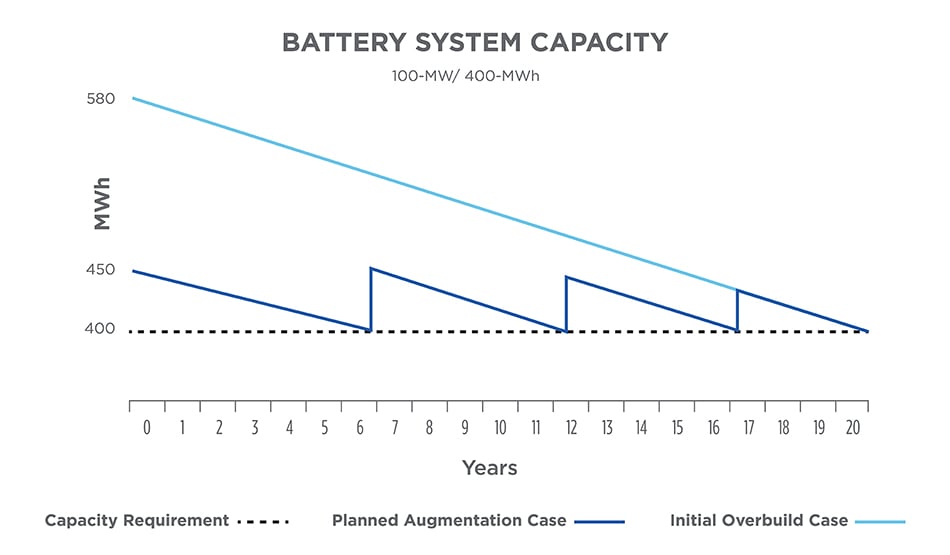Just as smartphone batteries lose capacity and degrade over time, batteries that make up a battery energy storage system (BESS) will also eventually degrade and will need to be replaced or supplemented to maintain outlined operational conditions throughout the system’s life span. BESS augmentation is the process of adding battery capacity as the system ages. The timing of augmentation can be affected by the amount of system capacity overbuilt on the front end of a project.
Initial Overbuild Versus Designed to Augment
Every time a battery is cycled, its capacity and efficiency slightly decreases. A project’s size, functionality and operating conditions can all impact how soon batteries will need energy augmentation — it could be one year, five years, or much further down the road.
A decision on whether or not to design an energy storage system for augmentation is based on several variables, including a project owner’s preference. Two main options exist: initial overbuild, which is the process of installing extra battery capacity at the start of a project to account for project lifetime degradation; the second option is to design for future augmentation that will add capacity throughout the system’s lifetime as additional capacity is required to maintain project performance.
Initial overbuild. If an owner decides to overbuild at the beginning of a project, more batteries are installed upfront to provide enough planned energy capacity to meet system requirements from project commissioning through most to all of a project’s lifetime. While taking this pathway will result in a higher capital expenditure (CAPEX) at the start of the project, it removes challenges associated with augmentation such as compatibility issues between current and developing technologies as well as unknown future material costs.
Historically, the price of batteries has dropped significantly, but the prices for lithium carbonate, copper and aluminum — materials that make up batteries — have all gone up in recent years due to a supply crunch coupled with inflation. It’s unclear when or if those costs will come down. Overbuilding the capacity initially does not rely on the future price of batteries, but if the battery price comes down and continues to decline, augmentation should be considered.
Designing to augment. A project owner may decide it makes more sense to design for periodic augmentation throughout the project life cycle and only install enough battery capacity to maintain required system output through a specific amount of time before adding additional storage capacity. The storage system will need to be designed to include space to hold future batteries. This decision lowers the project’s CAPEX, which may make the most financial sense for the owner and the project.
Owners should consider several things before deciding whether to wait to augment, including the fact that batteries purchased years down the road will likely be slightly different than the batteries installed on the project initially. This could result in technical challenges and compatibility issues.
Second, due to fire protection or insurance requirements or other code updates, the battery system may not be designed to the most recently adopted standards. Vendors design battery racks differently as technology evolves, so owners may need to replace more equipment than they had planned and budgeted for originally.
Also, batteries may not be available when needed due to manufacturing constraints. Supply chain issues are not new, but the problem has definitely grown. In years past when the demand for electric vehicles skyrocketed, battery manufacturers began to have more limited capacity. Since then, companies have built out more manufacturing lines, but rapid growth continues in both demand and use of EVs and stationary storage projects.
A benefit of waiting to augment is the likelihood battery technology will improve, possibly resulting in better battery performance, improved cycling and a longer battery lifetime. Currently, funding is being poured into new energy storage technologies, due to growth in EVs and a focus on renewables.
 Key Project Considerations
Key Project Considerations
The battery energy storage systems in operation today are still somewhat young, but the need for additional energy storage is growing rapidly. With the growth of renewables, reliable BESS technology is needed to fill those energy transition gaps smoothly.
Variables to consider before deciding whether to design to augment include:
- What is the degradation profile of the batteries purchased based on the project’s use case?
- What are the capacity requirements for the project (if there are any)?
- At what point (how many years) will those batteries no longer be able to meet the completed project’s capacity needs?
- What technology is expected to be available that can be used to augment?
- Does the site have space to augment?
- How does the augmented system tie in to the existing system and are there provisions for this?
- Can the existing balance of plant systems (communications, auxiliary power, etc.) handle the additional capacity?
- How does the augmentation impact the existing interconnection agreement?
Planning to meet future power requirements is tricky. Defining operational objectives and a project’s projected battery use will help owners determine the appropriate augmentation path.
A chilled water thermal energy storage system allows utilities to store energy during off-peak periods until it is needed, optimizing renewables while supporting customers’ energy needs.

